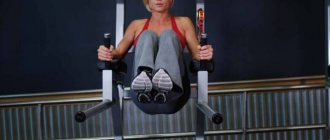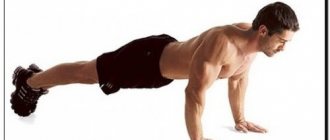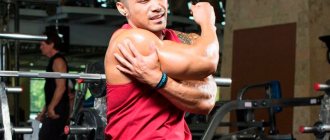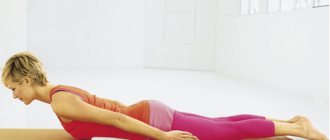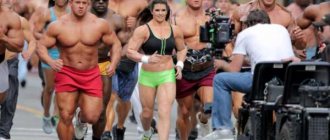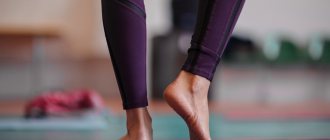Share:
What you need
- Dumbbells
Dumbbell thrusters or dumbbell throws are a fairly common exercise in CrossFit due to their technical simplicity and the fact that they do not require any additional equipment other than a pair of dumbbells. The dumbbell release option has more amplitude, which increases the efficiency of this exercise. This exercise is well suited for those who want to add variety to their training process and also increase the load on the deltoid muscles.
Today we will look at the main aspects related to the correct execution of this exercise, namely:
- What are the benefits of performing thrusters with dumbbells;
- Technique for performing the exercise;
- Typical beginner mistakes;
- Crossfit complexes containing dumbbell releases.
Executing Thrusters
The whole essence of the exercise comes down to sending the barbell straight over your head from a low squat position by standing up sharply. The basis of correct execution is a sharp extension of the knee and hip joints while simultaneously lifting the apparatus above the head.
Before starting to perform thrusters, it is necessary that the barbell is on the chest. To do this, it is best to perform a clean, or you can put the barbell on the racks and lift from there. But I would advise you not to be lazy and do what you can. Plus, performing cleans and thrusters consistently will save you a lot of time overall. This movement is called a cluster.
And so we figured out how to lift the barbell, now we move on, the barbell is on the shoulders in front of you, the grip is shoulder-width apart. We squat to a level below parallel with the floor, then rise sharply and at the same time send the projectile to outstretched arms.
The bar moves strictly, the hands actively press on it. At the top point, the arms are fully straightened at the elbows, the head is located between them.
From here the bar returns to its original position.
Thrusters are a speed-strength exercise that involves almost all the muscles of the human body and heavily loads the functional system of the body.
Execution technique
No matter how experienced a CrossFit athlete is, he can get injured if he does the thruster incorrectly. Therefore, performing exercises with a barbell requires careful adherence to technical rules.
Three prerequisites:
- correct, uniform breathing;
- warming up joints before training;
- precise technique for performing exercises.
These safety rules also apply when performing thrusters with kettlebells.
Learn the techniques for performing barbell exercises: front squats, back squats, lunges, pullovers, French bench press, biceps curls, Scott curls, Romanian deadlifts, bent over rows.
When climbing:
- keep your back straight;
- place your feet shoulder-width apart;
- the bar should be as close to the shin as possible (wear gaiters to avoid abrasions);
- straight grip or lock grip (for safety, so that the bar does not fall);
- do a squat (at the moment when the bar is above your knees);
- throw the barbell onto your chest, while at the same time squatting (full amplitude);
If you want to increase the effectiveness of the movement and thereby squat extremely low, then you need to work hard on stretching the adductor muscles of the thigh and quadriceps.
Important! In order to stand up correctly, you need to keep your back straight and maintain your balance.
In CrossFit, there is also such a type of exercise as a cluster, which consists of the following elements: taking the crossbar to the chest from the floor and subsequent thruster.
Basic errors of trusters
- Standing up and pressing separately
- Falling into a crouch
- Underdog
- Deflection in the spine
The athlete first lifts the barbell on his chest, and only then squeezes it with his arms, that is, he actually performs two different exercises.
It is necessary to lower yourself into a squat under control, and not fall through, otherwise this is fraught with knee injuries and besides, you miss the negative work of the leg muscles.
In this case, acceleration is lost, and this is the basis of the element.
When performing thrusters, you should avoid dangerous arching in the spine, otherwise you may suffer a back injury.
Trusters - diagram
1) Perform a barbell clean or remove the barbell from the rack into the starting position for a front squat. 2) Perform a squat, as you would during a front squat, until parallel, when your leg forms a 90° angle. 3) Start standing with the barbell on your chest and a moment before your knees are fully straightened, begin to push the barbell out while performing a standing press. 4) Ideally, the knees and elbows should be straightened at the same time, bringing the barbell slightly back, and moving the head slightly forward, so that an even line can be drawn through the center of the foot to the point where the hands rest on the barbell. 5) Lower the barbell to your chest, taking the starting position, and repeat the exercise again or return the barbell to the racks.
Trusters - Notes
1) It is recommended to perform the exercise in a power rack, which can prevent injury, since no one can “insure” you in this case. 2) It is recommended to use a weightlifting belt rather than a powerlifting belt, since the latter will “suffocate”. 3) For ammunition, it is also recommended to use wrist bandages and barbells, since the exercise is dynamic and there is no need for unnecessary instability of the apparatus or the athlete. 4) If you want to increase your strength results, then you can hold your breath at the lowest point, but keep in mind that this has a negative impact on health, so it makes sense to do this only during competitions, or when directly preparing for them. 5) Be sure to use the “pyramid” when building weights and do not round your back!
Exercises for the gym
STEROID STORE ADVERTISING
PAID PROGRAMS
Thrusters with weights
When working with kettlebells, you must keep in mind that they are more demanding on the stabilizer muscles (if performed simultaneously with two) than a barbell. Therefore, be careful when determining the weight of the projectile. So that you don’t get “stormy” once again while doing the exercise
Notice how the weights are positioned on your chest. They look in different directions; this position is optimal and allows you to practically not feel tired when holding the projectile.
We rise and throw the weights onto outstretched arms, while simultaneously turning the hand so that the palm faces forward.
We lower ourselves into a squat position and again turn the projectile to its original position on the chest.
I selected the weight of the kettlebell slightly incorrectly, and besides, I filmed the exercise after the complex, so the execution turned out to be a little clumsy. Well, okay, I conveyed the main meaning.
Video Thrusters with a barbell
When performing thrusters, we need mobility in the hip and shoulder joints.
Most athletes performing thrusters for the first time will have problems in the shoulder girdle. How to solve it and protect yourself from injury? First you need to stretch and massage your shoulder muscles well. If you haven’t read the article on warming up before strength training, I highly recommend checking it out. Using the Pro Muscle Roller massage roller, we roll out the gluteal muscle and biceps of the thigh, sitting on the roller and rolling the target muscle along it in different directions. All the muscles that we are paying attention to now are very important not only in thrusters, but in training in general. After rolling and massage, you need to warm up and stretch.
Benefits and what muscles work
When performing a thruster, the muscles of the whole body are involved, which is its undoubted benefit. It’s not for nothing that barbell throwing is considered an excellent way to develop strength and endurance.
In fact, this exercise is multi-component, which explains its versatile benefits for the development of not only muscles, but also joints and ligaments.
Related article: “Overhead squats”
If we talk about which muscles and muscle groups are most actively involved, the list will be impressive:
Moreover, the load of the last group depends on the depth of the squat: the lower it is, the more energetically the gluteal muscles will have to work, which means the stronger they will become.
But this is not the whole effect that the thruster gives: it activates metabolism, makes the cardiovascular system work more intensively and promotes ventilation of the lungs.
What are the benefits of this exercise?
When performing throws with dumbbells, the athlete shifts the emphasis of the load to the deltoid muscles, developing their strength and strength endurance. Adepts of kettlebell lifting practice something similar in their training, and their strength endurance is simply beyond comprehension - they are able to perform similar exercises for several minutes.
By working with dumbbells instead of a barbell, you also spend more energy on stabilizing your core and keeping your entire body working together.
It is important to include the hip and shoulder muscles in the work at the same time - this way the movement will be more explosive and the training intensity will increase.
What muscles work with dumbbell thrusters? The main load here is taken by the shoulders and hips, and all the core muscles and stabilizer muscles also work statically; without them, the movement will be “blurred”, and the release itself will resemble a standing dumbbell press. The dumbbell press is certainly a great compound exercise for developing the deltoid muscles, but for CrossFit we are more suited to explosive and coordinated work of the whole body. This is why thrusters are a great exercise for both beginners and more experienced athletes.
Execution options and main errors
The ability to vary the weight makes the barbell throw a multi-purpose exercise. If the goal is to develop muscle strength and power, then it is advisable to use more significant weights for throwing; if the goal is to develop muscle endurance and increase aerobic performance, then the weight can be reduced. You can also use dumbbells, kettlebells, or even a sandbag instead of a barbell.
Article on the topic: “Push-ups on rings”
Here are the most common mistakes athletes, especially beginners, make:
- the grip is too tight, so the forearms get tired too quickly, and it is difficult to do the required number of repetitions;
- when the barbell is above your head, for greater stability you need to squeeze it harder so as not to lose your balance;
- athletes who are completely focused on the correct technique forget about breathing - it should be rhythmic, without delay: inhale while squatting, exhale when the apparatus is above your head.
Benefits of a thruster
Thruster is a serious and compound exercise (using various joints) that includes the clean, front squat and push press. Since it includes several different movements, you get versatile benefits. The thruster allows you to work the large leg muscles (glutes, hamstrings, quadriceps) while performing a squat.
The force you generate in your legs travels through your entire body, through your lower back and abdominal region, and into your upper back, shoulders and triceps, helping you push the barbell overhead. Hell, it goes without saying that the thruster is an exercise for the whole body and in this it is extremely similar to our other friend - the burpee. And much like the burpee, the thruster is metabolically demanding and greatly increases your heart rate, which in turn helps improve the efficiency of your cardiovascular system.
But, unlike burpees, the thruster allows you to change the weight used (unless you wear a weight vest while doing burpees, but that smacks of perversion). By adding weight and making the thruster a harder exercise, you develop strength and power in your muscles. By reducing weight and making the exercise easier, you can focus more on developing muscular endurance and aerobic performance. After all, thrusting is a multi-faceted exercise.
It is usually performed with a barbell, but it can easily be replaced with dumbbells, a sandbag, a medicine ball or kettlebells. In fact, this is not the entire list of alternatives. Seriously, the thruster is extremely versatile, it is good both on its own and in combination with other exercises... with burpees, for example (just kidding).
Kalsy
Earlier in my articles I wrote about this wod, the main thing is because it is one of the most difficult workouts in CrossFit. Kalsu is a heroic complex in honor of Robert James "Kalsu", a former American professional football player who left his sports career to serve his country during the Vietnam War.
RX option
At the start of every minute until you complete 100 thruster repetitions
5 burpees
Maximum number of thrusters (61/38)
Scaled version
3 burpees
Maximum number of thrusters (43/29)
What is a thruster
Thruster is a complex strength exercise that can use various joints. There are different types of thrusters, including a thruster with kettlebells and dumbbells, but the most popular is the CrossFit with a barbell.
This exercise consists of the following strength elements:
- cleans and squats;
- press press
CrossFit puts a lot of stress on the leg muscles, namely:
- hamstrings;
- quadriceps muscles of the legs;
- gluteal muscles.
Barbell thrusters are incredibly beneficial because they provide multiple strength movements that work the entire body. Despite all its usefulness, CrossFit is not a particularly strenuous exercise. The main thing here is to smoothly repeat the thruster many times with a small weight. Only in this situation will the exercise bring the promised benefits.
Did you know? The exercises in CrossFit are named by the athletes themselves. Light sets of exercises are called by feminine names, and heavy ones by masculine names. Moreover, heavy complexes are named after fallen male heroes (military, firefighters, etc.).
HEAVY FRAN
In 2013, CrossFit HQ did a workout video with Rich Froning and Rory McKernan doing Fran's workout with a few modifications: 61kg thrusters and strict weighted pull-ups.
Heavy Fran Time: 12-15-9 Thrusters 61 kg Strict Pull-Ups with Dumbbells 20 kg (Place the dumbbell between your legs.)
Classic Fran Thrusters 42.5 kg/29 kg Pull-ups
Lightweight Fran: Thrusters 20 kg
Horizontal pull-ups to rings
Exercises
Each complex strength exercise requires attentiveness, concentration and correct execution. To avoid injury and other undesirable consequences, the following rules for the execution of the thruster must be observed.
Barbell Chest Raise
The beam should be in front of the athlete on the shoulders, and the bar should be on top of the back. During squats, keep your back straight so that the bar is over the center of your foot. This way it will hold up when squatting.
Thrusters require athletes to have good flexibility in the wrists, shoulders and hips. Therefore, the CrossFit technique with a barbell on the shoulders is much more difficult than squats with a barbell on the chest, since the back must always be straight, without the slightest bending.
Important! The thruster is designed to train endurance; with such exercises, the quadriceps and deltoid muscles are well pumped, and the heart rate also increases.
Front Squat
The front squat is aimed at training the legs. When performing a front squat, your heels should not come off the floor, so you keep your weight on them. Pull your elbows and then stand up. It works the hamstrings, quadriceps, glutes, and the front and back of the body.
Did you know? CrossFit competitions have been held since 2007. An interesting thing is that the disciplines in which athletes will compete are announced only a few hours before the start of the games.
Barbell overhead
From a front squat, you should smoothly move into a standing position with the apparatus overhead. In CrossFit, this transition occurs simultaneously. When getting up, you must throw the barbell up until your arms are completely straightened, then fix the bar in this position for a few seconds.
The best exercise in CrossFit is TRASTER
If there's one exercise whose name is synonymous with CrossFit, it's definitely the thruster. Heck, the term “thrust” was created by CrossFit. Ask three-time CrossFit Games champion Rich Froning what he considers the best exercise, and he'll definitely say the thruster.
So what makes the thruster such a valuable exercise? Below we will discuss all the benefits of the thruster, as well as some tricks that will help you perform this exercise more effectively. But before that, let's figure out exactly how to do this.
Truster
Feet should be shoulder-width apart, your lower back should be tense and arched, and the barbell should be placed on your shoulders. In this case, the hands should be on the bar at shoulder width or narrower, and the elbows should be brought forward, thus the hands create a kind of shelf. Try to keep your chest and head straight in line, push your pelvis back and lower yourself into the bottom squat position so that your pelvis is below your knees. From the bottom position, make a rapid rise to the starting position as quickly as you can and, using this momentum, simultaneously throw the barbell overhead. You should finish the rep in a rack position with the barbell above and slightly behind your head, with your shoulders locked directly above your hips and your hips locked directly above your knees. Then slowly lower the barbell and lower yourself into the next squat, continuing the exercise with continuous movements. Benefits of a thruster
The thruster is a serious and compound (multi-joint) exercise that includes the barbell clean, front squat, and push press. Since it includes several different movements, you get versatile benefits. The thruster allows you to work the large leg muscles (glutes, hamstrings, quadriceps) while performing a squat. The force you generate in your legs travels through your entire body, through your lower back and abdominal region, and into your upper back, shoulders and triceps, helping you push the barbell overhead. Hell, it goes without saying that the thruster is a full-body exercise and in this it is extremely similar to our other friend - the burpee. And much like the burpee, the thruster is metabolically demanding and greatly increases your heart rate, which in turn helps improve the efficiency of your cardiovascular system. But, unlike burpees, the thruster allows you to change the weight used (unless you wear a weight vest while doing burpees, but that smacks of perversion). By adding weight and making the thruster a harder exercise, you develop strength and power in your muscles. By reducing weight and making the exercise easier, you can focus more on developing muscular endurance and aerobic performance. After all, thrusting is a multi-faceted exercise. It is usually performed with a barbell, but it can easily be replaced with dumbbells, a sandbag, a medicine ball or kettlebells. In fact, this is not the entire list of alternatives. Seriously, the thruster is extremely versatile, it is good both on its own and in combination with other exercises... with burpees, for example (just kidding).
Tips for Improving Thruster Performance
There are plenty of videos on the Internet that talk about thrusters, but if you have to choose from thousands, watch this video by Jason Khalipa, the 2008 CrossFit Games champion. This man won by a small margin in the very last competition and that competition was... thrusters (actually it was lifting a barbell from the ground to an overhead position, but there were no rules then that the athlete had to stop at any point, so that we can say that Khalipa is the person who opened the thruster).
In addition to Khalipa's video, read on for helpful tips that will help you perform thrusters more effectively and improve your results. Use your heels
Remember that the first part of the thruster is more of a squat clean or a power clean followed by a front squat. In both of these exercises we focus on the heels. As soon as you put your weight on your toes, you create momentum that pushes you forward, and you have nothing to push off from, which means you lose all power. During the thruster, the bar should move up and down in a straight line in a vertical plane. As soon as you stop standing on your heels, you begin to stagger back and forth, which means that the barbell will no longer move in a vertical plane, which will lead to a lot of unnecessary movements on which you will waste your strength. Your thighs and legs are your best friends
I'm sure you've heard the command "Knees out" many times before. while performing weightlifting exercises. The reason is that by turning your knees outward, you engage your glutes and generate more energy, allowing you to lift heavier weights. Some of these principles also apply to thrusters. Point your knees apart and push as hard as you can, creating momentum that will help push the barbell over your head and save your arms from unnecessary strain. After all, by using your leg strength correctly, you will be able to lift more than relying on arm strength alone. Keep your elbows high
This is a common mistake that severely limits an athlete's performance in a given exercise. Once again, the first part of the exercise is a barbell clean or barbell squat. Accordingly, if your elbows are pointing down, then the entire weight of the bar will literally pin you to the floor, making it difficult for you to try to get up. Keep your elbows raised, forming a stable platform for the barbell, allowing it to rest without straining your arms while you do all the work using your leg strength, as discussed above. Try to keep your movements smooth
I know I've talked a lot about how the thruster is based on the barbell squat and the barbell press, but really, the best way is to perform the thruster in one continuous, fluid motion. It may be a little more difficult, but unless you are able to perform a thruster in one motion, the weight of the barbell is too heavy for you. This is a mandatory condition - you should not allow pauses in the middle of performing a repetition, otherwise you should work harder on performing overhead presses or squats with a barbell on the front. Instead, if you need a short rest, stop when the bar is above your head or when you have lowered the bar to your chest after completing a successful rep. Once you begin the squat phase, treat the entire exercise as a whole and don't stop until it's finished. Don't dig into the bar too much
At least while she's lying on your chest. If your grip is too tight, your forearms will quickly tire during thrusters, so loosen your grip whenever you can. When the barbell is above your head, squeeze it a little harder to avoid instability or accidentally dropping it. Breathe
In most workouts, the inclusion of thrusters in the program means that the WOD is designed to knock the wind out of you. Many people forget to breathe when performing thrusters because they are too afraid to make a mistake in the movement. Not worth it. Better use your breathing to maintain a certain rhythm. Try to take one breath in and out on the thruster. Inhale as you go down, exhale when the bar is above your head. Rest when you need it
Listen, only you know what you are capable of and where your limit is. You may think that you are able to perform the thruster very quickly, but if you have not mastered the technique, you can very quickly fly out of rhythm and even before you understand what happened, you will feel the bar filling up with weight, and you can’t there is enough air. Of course, there are exceptions, like Sam Briggs doing the 14.5 complex, but I would advise you to pay attention to Richie Froning's strategy when performing the same complex. He knows his limit and his capabilities, so he maintained a steady rhythm, pausing briefly when the bar was above his head. He eventually caught up and passed Briggs for the win. Whether you're resting with the bar on the ground, on your chest, or above your head, give yourself a breather, but don't let the thruster get the better of you. Rest too long will make it much harder (mentally) for you to lift the barbell again and finish all your reps.
Source: https://wodloft.ru/text/v-chem-sut-trastera.html
Typical execution errors
The most common mistakes CrossFit fans make when doing barbell exercises:
- Elbows and knees are not kept under observation. The technique involves the correct movement of the knees, at an angle proportional to the location of the toes;
- throwing the barbell onto the chest incorrectly;
- take a lot of weight on the barbell. This approach does not keep the back straight and the athlete may be subject to serious injury. In this case, the weight needs to be reduced in order to perform thruster exercises correctly.
Execution Features
Thruster is an extremely energy-intensive exercise, and when performing multi-repetition sets, the pace of movement is important: you must determine your individual pace, which will allow you to breathe deeply and maintain performance for as long as possible.
The muscles of the legs, buttocks and lower back play a key role when performing thrusters. The shoulder girdle serves only a supporting role, so for your thruster to be effective, you need explosive power from your legs. This exercise involves throwing the barbell from a squat position, rather than just a standing press.
Advanced Thrusters
Barbell thrusters are a movement that combines the front squat and overhead press. They work magically for those looking for intense heart function, muscle hypertrophy, and weight loss.
• We also recommend reading: “Effective lunges: how to do lunges with a sandbag correctly?”
This exercise is often used by experienced athletes who have mastered basic lifting techniques, and especially by advanced CrossFit athletes. When professionals perform thrusters, it looks athletic and graceful. For example, consider the barbell release of Rich Froning doing a heavy Fran.
Of course, in theory, this should be a great exercise for any athlete, as it uses almost every muscle in the body and can raise your heart rate to its maximum in a short time.
Main mistakes
But, if some people can do thrusters perfectly, this does not mean that this exercise is suitable for any athlete. It's akin to watching the Olympic diving performances on TV and going into the backyard with your friends and trying to repeat all the tricks you just saw on the screen.
Analysis of the exercise
Anatomy of exercise - which muscles work
- Main muscles : quadriceps, deltoids, gluteal muscles.
- Accessory muscles : triceps brachii, hamstrings, abs and spinal extensors, calf muscles, trapezius muscles, forearms.
Advantages
- Increases the efficiency and fitness of the cardiorespiratory system.
- Involves all the muscles of the body in a complex.
- Develops strength and aerobic endurance.
- It provokes a powerful metabolic response, making it well suited for weight loss workouts.
- Develops coordination.
- The load in the exercise is easily dosed and changeable.
Flaws
- The barbell throw is a difficult-to-coordinate movement that requires the athlete to have good physical preparation and knowledge of technique.
Preparation for execution
Preliminary mastery of the technique of front squats, push-ups, and cleans will be a good help in preparing the athlete to perform thrusters. Practice each of the elements (“phases”) in stages, so that you can then combine them into one solid movement.
Before moving on to using a barbell, it is recommended to practice with lighter equipment - dumbbells.
Before performing thrusters, you should warm up thoroughly. The preparation stage should include not only joint exercises, but also cardio exercise - 5-10 minutes of running or other aerobic activity will prepare the cardiovascular system and help avoid a sharp drop in blood pressure.
Proper execution
- One repetition is one continuous, integral and uniformly accelerated movement of the projectile. Slowing down the pace of transition between phases reduces the efficiency of movement.
- The execution of a shvung is preceded by a deep squat, which allows you to develop a powerful force with your legs and transfer an impulse of energy to the projectile. The guideline for most is the position in which the hip joint at the lowest point is located below the knees.
- The projectile moves along a vertical or close to vertical trajectory, “balancing” the athlete’s center of gravity. This allows you to spend a minimum of effort on effective movement.
- Essentially, lifting the barbell is performed using the leg muscles and the inertia they create (due to the sharp extension of the knee and hip joints when coming out of the squat). Only push-ups in the upper phase are performed by hand.
- When the apparatus is in the chest position, the elbows should be directed forward and the shoulder should be approximately parallel to the floor. This allows you to comfortably hold the bar on your deltoids without loading the muscles of your arms, and thereby save energy.
- The projectile is squeezed with straight arms and fixed clearly above the head or slightly behind. If the barbell (or any other apparatus) is positioned in front of your head, the repetition will not count.
- In the top position, the body forms a line - all joints should be straightened. If we talk about a competitive approach to assessing technique, then incompletely straightened elbows or knees are a reason to not count a repetition.
- Inhale as the barbell moves down and exhale the air from your lungs as you push the barbell out (at the stage when your arms are engaged).
- There are two techniques for performing the exercise: the clean is performed in a rack with further movement into a squat, or the clean is performed immediately into a squat. The second option is more preferable, since it makes it possible to “compose” the movement and make it more energy efficient.
Errors
- Pauses during the movement, dividing the movement into “components” - bench press and squat.
- Insufficient squat depth.
- Active participation in the movement of the arm muscles.
- The projectile is brought forward (in front of the head).
- Shifting the center of gravity to the toes.
- Uncontrolled dropping of the barbell down.
- Incomplete extension of the elbows at the top point.
Inclusion in the program
Include the exercise at the very beginning of the training complex, when non-tired muscles allow you to perform the exercise as technically as possible and with full dedication.
The inclusion of thrusters in training plans is usually aimed at developing endurance. In addition, the exercise can be used in programs aimed at losing weight, as it is very energy-consuming.
In both the first and second variants of application, the work mode should be multi-repetitive, so the athlete should use a relatively light weight projectile and perform 15-25 repetitions with it in 3-4 approaches.
Thrusters can also be performed over time, constantly increasing the duration of the cycle (a more effective scheme for stimulating fat burning mechanisms).
You should not discount the exercise in terms of developing strength indicators. Thrusters with a barbell, performed for 3-5 repetitions with an appropriately selected amount of weight, will help you effectively progress and improve your physical fitness.
Tips for efficiency.
- In order to develop more effective force, some athletes prefer to perform squats with the thigh hitting the shin.
- In the upper “phase” of the barbell push, it is advisable to relax the muscles of the legs. Short moments of rest allow the muscles to partially recover and thus delay the onset of fatigue.
- If the amplitude of the squat “suffers,” additionally work on flexibility and stretching of the hip muscles.
Contraindications
- The thruster exercise requires absolute health and good mobility (mobility) of all joints involved. If an athlete has problems with his shoulders, spine or knees, he should avoid performing thrusters.
Interesting fact Jason Calip is considered to be the inventor of thrusters.
The thruster exercise was “born” by accident when a Californian athlete set another personal record in lifting the barbell from the ground to the overhead position at the 2008 CrossFit Games. How to replace the exercise
The barbell is not the only piece of equipment that can be adapted for functional training. To perform thrusters, essentially any “weight” is suitable - dumbbells, kettlebells, a sandbag, a medicine ball or a barbell disc. Using free weights that you have on hand, you can diversify your workouts and change the load.
But it is worth keeping in mind that using two equipment (dumbbells or weights) requires more coordinated work and strength of the stabilizer muscles. Therefore, in this case, it is important to be able to adequately assess your strength and select the load in order to avoid injury.
Barbell Chest Raise
The starting position for the thruster is a front squat. And, of course, it’s no secret to you that in order to accept it, you first need to hoist the barbell on your shoulders.
Photo from boxrox.com
Take the starting position: feet shoulder-width apart, the barbell is above the phalanges of your big toes. Grasp the bar with a lock grip, turn off your elbows. Start lifting the barbell in front of you. When the bar is at mid-thigh level, sharply straighten your hips and lift your shoulders, while simultaneously going into a squat, fixing the barbell on your shoulders. Stand up from your seat to complete the exercise.
Grip and elbow position
When performing thrusters, you can hold the barbell with any grip: open or closed. In this case, you do not need to raise your elbows high up; it is important to hold them in such a way as to maintain the pace of the exercise and not overload your shoulders and arms. The most important thing is that the bar does not drag you forward and your back does not hunch.
All work, consisting of two main parts - front squatting and throwing the barbell up - is performed together. This means that immediately after rising from the squat there is no pause, and the barbell is thrown upward using the inertia from rising from the squat. If your physical fitness allows, then when lowering the barbell from the top point, the movement is performed continuously, without a pause on the chest: after lowering to the chest, you immediately go down into a squat. If you do it in a row, without pauses, or as they say in CrossFit, “touch and go,” it is not possible, then you can pause after lowering from the top point to the chest. In this position, you should do one or two cycles of deep breathing and continue with the next repetition. The pace of movement is set by the legs from a squat. After fully straightening from the top point, lower the barbell down. The moment it comes to your shoulders, start squatting.
Lack of flexibility = low efficiency
Many people have some limiting factor that prevents them from performing quality reps (especially with light weights). The bar should rest on your shoulders so you can use your entire body to accelerate the bar, rather than just your arms (which will take more strength).
If you fall into this category of exercisers, then you need to make sure that you pay enough attention to working on your mobility. This is important for improving your driving efficiency and safety.
Sources
- https://fit-box.xyz/weightliftingexersise.php?id=211
- https://krasota-zdorove.com/crossfit-uprajneniya/vybros-shtangi.html
- https://fit-box.xyz/article.php?id=276
- https://lifegid.com/bok/1863-chto-takoe-traster-osnovnye-uprazhneniya-i-tehnika-ispolneniya.html
- https://monko.net/article/eto-luchshe-chem-trastery
- https://www.cross.world/vybrosy/
[collapse]
Other fitness exercises from CrossFit
More trained athletes often include the following exercises in CrossFit training:
- Single leg squats. Stand on one leg, straighten your arms in front of you. Stretch the other leg forward as well. Squat in this position, trying to keep the other leg perpendicular to the body. Do the required number of repetitions and repeat the exercise on the other leg.
- Rowing at an accelerated pace. The element is performed on a special simulator and helps to work out all muscle groups of the body.
- Jumping onto the cabinet. To perform this exercise, as a rule, boxes with a height of 50 to 75 cm are used. However, beginners can use an attribute with a smaller height. To perform the element, you need to stand facing the box with your feet together or slightly apart. The feet should be parallel to each other. Swinging your arms up and down, jump off the ground and jump onto the box. In this case, the back should be straight, the knees should not bend too much. It is important to land fully on the box with both feet. Then take the starting position by jumping back and repeat the exercise the required number of times.
- Pull-up with access to the top. Hang on the horizontal bar so that your feet do not touch the floor, and all your fingers are on top of the bar. From this position, lift your body up to chest level with your arms and straighten them, lifting your body over the bar to hip level. You need to learn to do this in one movement without stopping.
- Burpees. Assume a position similar to straight-legged push-ups. Do one push-up, pull your knees to your chest and place your feet on the floor. Lift your hands off the floor and jump up, clapping your hands. Then take the starting position again and perform the required number of repetitions.
These are just some of the exercises used in CrossFit. In training, various types of weights are used, basic exercises (push-ups, squats) become more complicated. Regularly practicing this sport will help you see from your own experience that the capabilities of the human body are almost limitless.
